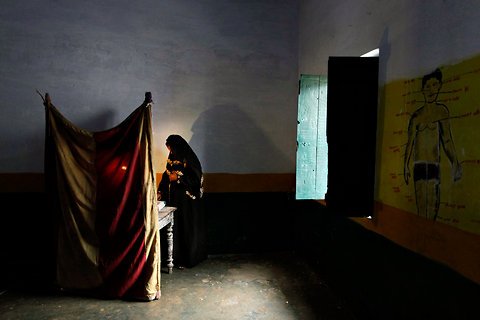
An Indian Muslim woman casts her vote at a polling station in Gonda, Uttar Pradesh, Feb. 8, 2012. Photo: Rajesh Kumar Singh/Associated Press
A chill ran down Ruby Rizvi’s spine when, about three weeks ago, she heard the footsteps of hundreds of people outside her house near Mahboob Ganj Chauraha in Lucknow. After ensuring the safety of her three children, she peeped out of the window of her first-floor home. The mob, some 1,500 strong, she estimates, approached her husband’s pharmacy on the ground floor, with swords and metal rods.
Within minutes, they had wrecked it and looted stock worth about one million rupees, or $20,000.
Zaheer Rizvi, Ruby’s brother, attributes the attack to the longstanding antagonism between Shiite and Sunni Muslims in the area. The Rizvis are Shiites, while the attackers were Sunni, he said. “Their attire clearly showed that they were from the other community,” he said, noting that they wore smaller skullcaps.
Since the Samajwadi Party came to power in Uttar Pradesh in March, there has been a renewed sense of optimism that certain “Muslim issues’’ would be carefully dealt with. One of the main campaign promises made by the new chief minister, Akhilesh Yadav, was that a quota for schools and state jobs would be established for Muslims based on population. The state is 18 percent Muslim, and their support is critical for any party.
“I am sure Akhilesh Yadav’s leadership will change things around. He has a passion to solve our problems,” the spokesman of the Shia Personal Law Board, Maulana Yasoob Abbas, said in a recent interview.
Hopes were raised further last week when the president of Samajwadi Party, Mulayam Singh Yadav, increased the strength of the Muslim cabinet ministers in the government by appointing more muslims to the cabinet and appointed district magistrates and superintendents of police from among the muslims, a concession to demands made by the Shahi Imam, the lead Imam of the Jama Mosque in Delhi, Syed Ahmed Bukhari.
Muslim leaders are now looking to the Samajwadi Party to work with them on improving literacy and employment rates among Muslims, which fall far below the state average. “I have traveled from Meerut to Muzaffarnagar to Bijnor. The main demand of the community is that employment be provided for,” said Maulana Abbas, adding that “they should open more Urdu schools, employ more Urdu teachers and grant reservations for Muslims in government jobs.”
Many leaders are optimistic that the Samajwadi Party will also help quell the Shia-Sunni violence that has rocked eastern Uttar Pradesh for decades. They say the frequency and intensity of the conflicts did not decrease during the reign of the last chief minister, Mayawati, who goes by one name. “If only Mayawati could control the violence, it wouldn’t have gone out of hand,” said Maulana Abbas. But instead of trying to broker peace, “she alienated herself from the masses,” he said.
Shiite and Sunni sects have clashed here for generations. Some attribute it to the fact that the former Avadh Kingdom, in present-day eastern Uttar Pradesh, was ruled by the minority Shiite community (estimated at 10 to 15 percent of the Muslim population in India) for decades before the British took over, leaving the majority Sunnis resentful. Others blame non-Muslim politicians. “The current crop of political parties began all of this,” said Nawab Mir Jafar Abdullah, a descendant of Nawab Wajid Ali Shah, the last ruler of Avadh. “They wanted to divide the Muslim vote so they can get the support of the sections of the community.”
The Samajwadi Party has enjoyed strong Muslim support since its formation in the early 1990s, because it was seen as standing against the central government when the Babri Masjid Mosque was being demolished by the Bharatiya Janata Party. Still, it lost to Mayawati’s party in state-wide elections in 2007. Some Muslim leaders say that was because the party failed to keep its promises such as reservations made to the Muslim community.
While there are no official statistics on Shiite-Sunni violence in Uttar Pradesh, frequent bloody clashes have been reported in recent years, occasionally resulting in deaths. In February, the police used tear gas and charged crowds with lathis, or bamboo sticks, during a Sunni procession to mark the anniversary of Prophet Muhammad’s birth, after stone-throwing broke out between Sunnis and Shiites. The violence left dozens injured, according to news reports, and engulfed most of Lucknow’s Old City.
Much of the violence has centered around religious parades and festivals; community leaders have responded in the past by banning some processions and establishing new routes for others. Other disputes have dragged on for generations: The Supreme Court recently directed the UP government to settle a battle between the sects over a cemetery in Varanasi’s Doshipur area that is more than 130 years old. Similar clashes over land and property have gone to court in the Deoria, Azamgarh and Mirzapur districts.
The violence is all the more notable because Lucknow and the surrounding area is known for its relative communal harmony. “There hasn’t been a single act of Hindu-Muslim violence here,” said Nawab Abdullah.
Lucknow residents like Ms. Rizvi say they have had enough. “This is my home and all I want to do is live in peace,” Ms. Razvi said.
Published in: The New York Times
Published on: 18 April, 2012
Link: https://india.blogs.nytimes.com/2012/04/18/can-the-samajwadi-party-ease-u-p-s-shia-sunni-conflict/

